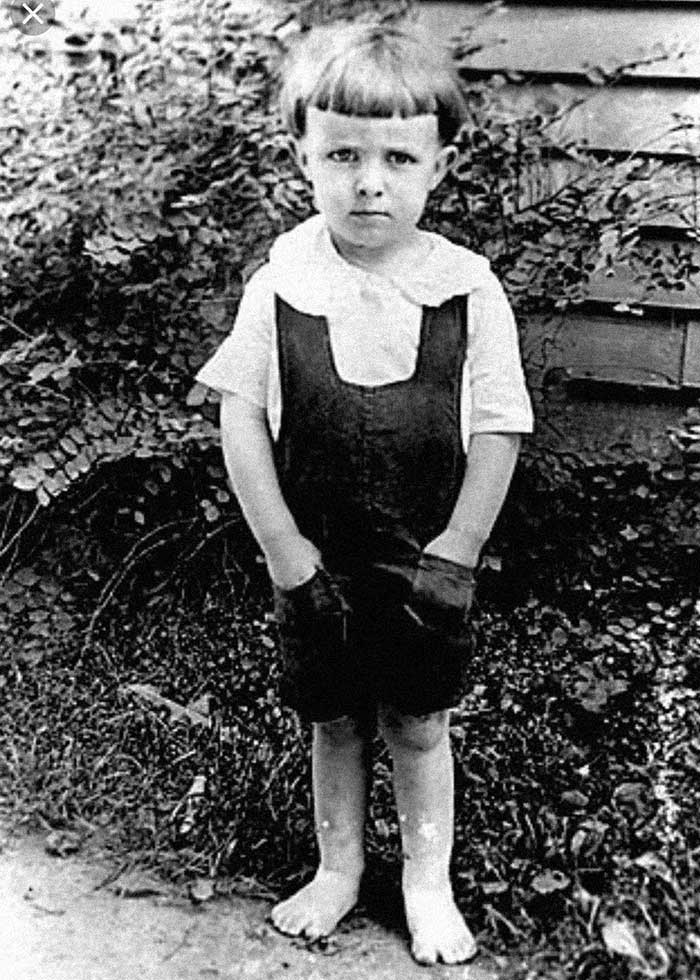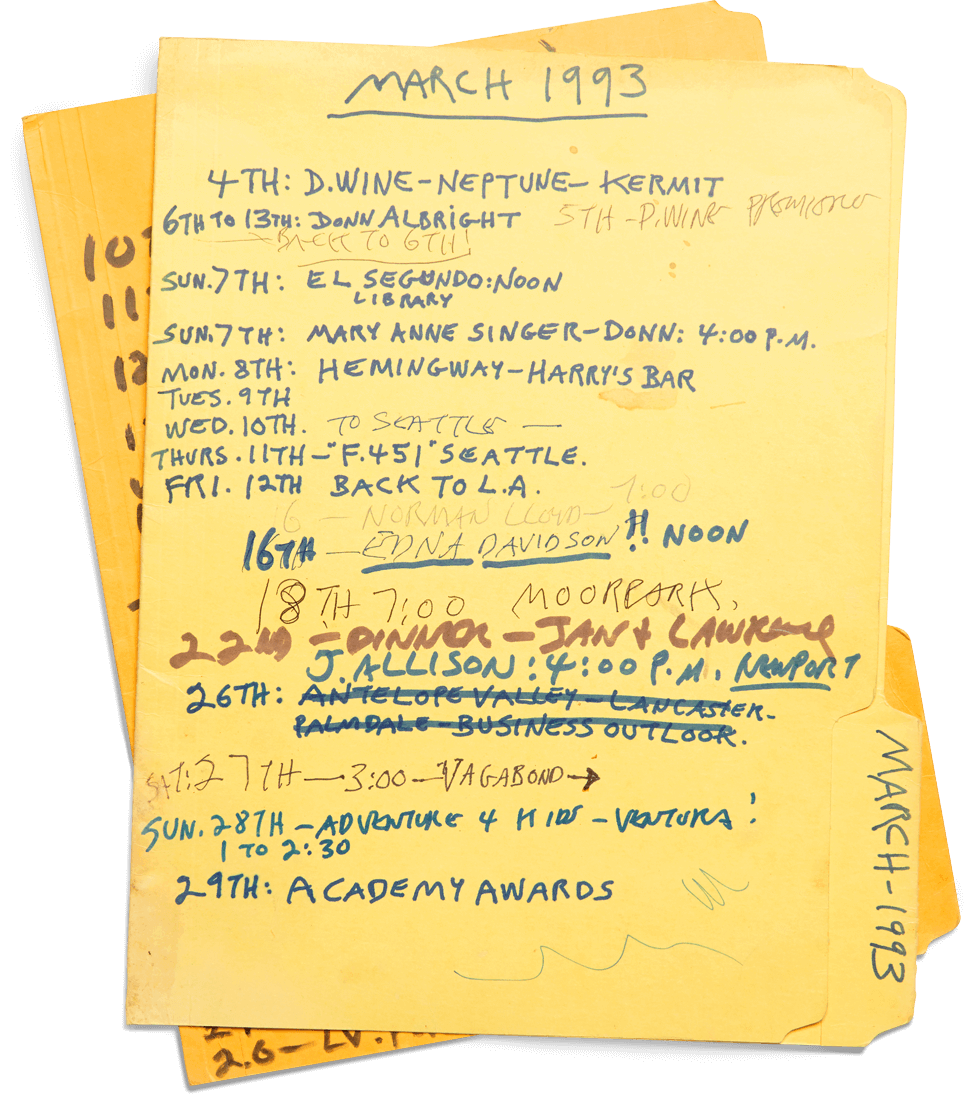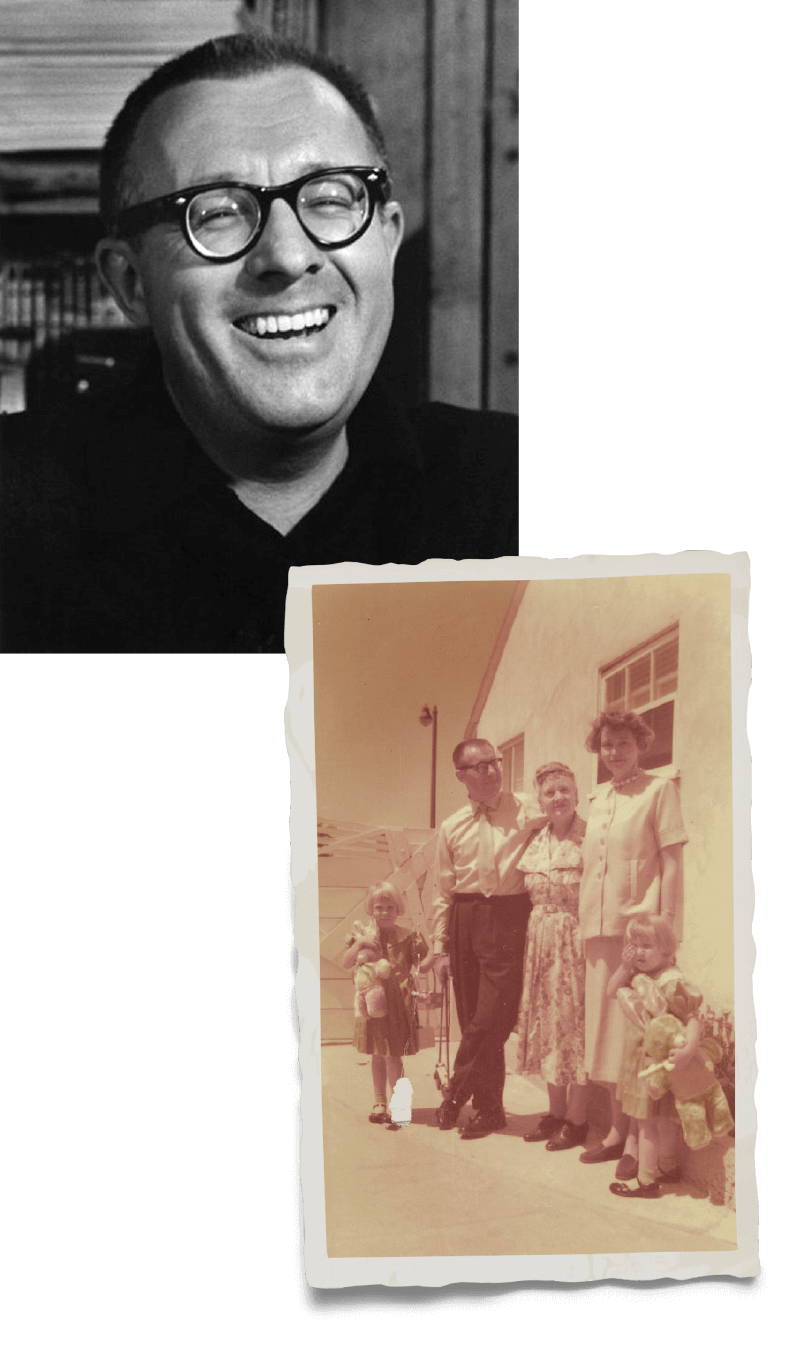Ray Bradbury

‘We are cups, constantly and quietly being filled. The trick is, knowing how to tip ourselves over and let the beautiful stuff out.’
Ray Bradbury inspired generations of readers and viewers to dream, think, and create. His childhood was spent in the Midwestern small town of Waukegan, Illinois, and he mastered his craft in Los Angeles, where he forged a special creative bond with the city and its many cultures, raised his family, and drew as feverishly as he wrote. (The doodles throughout this website are just a mere sampling.) Yet Bradbury always maintained strong ties to his small-town upbringing. He often told the story of an encounter with a carnival magician, Mr. Electrico, who reached out to the twelve-year-old Bradbury, touched him with his energy-charged sword, and commanded, “Live forever!” Bradbury said, “I decided that was the greatest idea I had ever heard. I started writing every day. I never stopped.” And the literary landscape—as well as the broader American cultural landscape, from Hollywood to NASA—would never be the same again.
During a career that spanned seventy-plus years, he wrote more than 400 short stories and nearly fifty books across a variety of genres. He also penned numerous poems, essays, plays, operas, teleplays, and screenplays, making him one of the most productive and admired writers of our time, as well as one of the most widely translated in the world.
His enduring novels, novelized story cycles, and story collections include The Martian Chronicles (1950), The Illustrated Man (1951), The Golden Apples of the Sun (1953), Fahrenheit 451 (1953), The October Country (1955), Dandelion Wine (1957), A Medicine for Melancholy (1959), and Something Wicked This Way Comes (1962).
Bradbury’s many subsequent books include the children’s fantasy The Halloween Tree (1972); the detective novel trilogy Death Is a Lonely Business (1985), A Graveyard for Lunatics (1990), and Let’s All Kill Constance! (2003); an essay collection on creativity, Zen in the Art of Writing (1989); a roman-à-clef based on his work in Ireland with John Huston, entitled Green Shadows, White Whale (1992); the supernatural novel From the Dust Returned (2001); the poetry collection They Have Not Seen the Stars (2001); the nostalgic sequel to Dandelion Wine, Farewell Summer (2006); and nine short story collections written during the final five decades of his life. In addition, 200 of his short stories were published in two story collections, The Stories of Ray Bradbury (1980) and Bradbury Stories (2003). Further, his stories earned individual honors in two O. Henry Prize anthologies and four Best American Short Stories volumes, and continue to appear in hundreds of textbooks for new generations of readers.
When Bradbury used his gift as a master visual storyteller to venture into film and television, millions more discovered his work. He wrote the screenplay for John Huston’s classic 1956 film adaptation of Moby Dick, was nominated for a 1962 Academy Award, and won an Emmy for his teleplay of The Halloween Tree in 1993. The Ray Bradbury Theater, a TV series for which he adapted sixty-five of his stories, also earned several awards, and more of his stories were adapted for Rod Serling’s The Twilight Zone, Alfred Hitchcock Presents, and The Alfred Hitchcock Hour. On the big screen, many feature films were based on his work, including It Came from Outer Space (1953), The Beast from 20,000 Fathoms (1953), Fahrenheit 451 (1966 and 2018), The Illustrated Man (1969), Something Wicked This Way Comes (1983), The Wonderful Ice Cream Suit (1998), and A Sound of Thunder (2005).

During the Space Age, Bradbury emerged as a leading futurist through his stories, books, articles, and lectures. His ideas transcended the boundaries of fiction and became the real-life dreams of astronomers, astronauts, planetary scientists, and mainstream readers of all ages. Few individuals in the world have received as many Space-Age recognitions as Bradbury. In his honor, the Apollo 15 crew named a moon crater “Dandelion,” an asteroid was designated “9766 Bradbury,” rocks on Mars were named “The Martian Chronicles” by the Spirit and Opportunity Mars Exploration Rover scientific teams, and the Phoenix Mars Lander carried a digital copy of The Martian Chronicles aboard when it traveled to the high northern latitudes of Mars. Valles Marineris, one of the deepest chasms of the Martian Grand Canyon, has been unofficially renamed the “Bradbury Abyss” by his fans.
Many accolades have been bestowed on Bradbury, including the World Fantasy Award for Lifetime Achievement, the Science Fiction and Fantasy Writers of America Grand Master Award, and the Bram Stoker Award for Lifetime Achievement. Among his most distinguished honors are the National Book Foundation Medal for Distinguished Contribution to American Letters, received in 2000, followed by the National Medal of Arts from President George W. Bush in 2004, and the Commandeur of the Ordre des Arts et des Lettres from the French government in 2007, a year that also saw Bradbury receive a Pulitzer Prize citation, recognizing his “prolific and deeply influential” career.
"I have never listened to anyone who criticized my taste in space travel, sideshows or gorillas. When this occurs, I pack up my dinosaurs and leave the room."
– R.B.


From Ray Bradbury’s Pulitzer Prize Special Citation, 2007
‘Ray Bradbury is one of those rare individuals whose writing has changed the way people think. His more than five hundred published works—short stories, novels, plays, screenplays, television scripts, and verse—exemplify the American imagination at its most creative. Once read, his words are never forgotten. His best-known and most beloved books, The Martian Chronicles, The Illustrated Man, Fahrenheit 451, and Something Wicked This Way Comes, are masterworks that readers carry with them over a lifetime. His timeless, constant appeal to audiences young and old has proven him to be one of the truly classic authors of the 20th century—and the 21st.’
